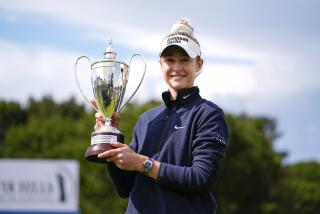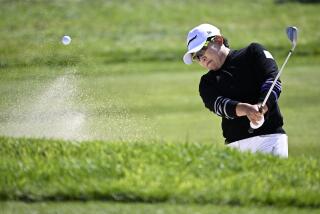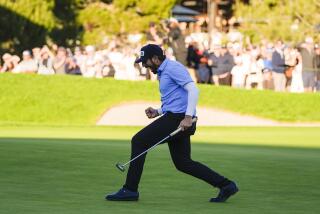Key to Success Is Playing Hurt
RANCHO MIRAGE, Calif. ŌĆö The next time you go to your golf pro and he starts to teach you the basic secrets of successful play--where to put your feet over a four-iron, where the Vees should point at address or how to make a one-piece takeaway on the tee, get rid of him.
He doesnŌĆÖt know the first thing about winning golf.
Any pro who starts teaching you the mechanics of the game, who thinks you need to make your swing more upright or your knees more bent, is going about it all wrong.
What he should be telling you is to forget about golf for a while, go home and try to miss the top step of a flight of stairs. Walk into a door some place. Get a sprained ankle. Trip over a curb. Have a minor car accident.
Run a temperature. Go play in the rain, sleep in a draft. Never mind getting a grooved swing, get the gout. Get a headache. Get a head cold.
Shucks, go play touch football. Forget the putter, go put some stress into your bag.
The jury is in. Golf is best played with a slight fever, a limp, a pain in your ear or eye. If youŌĆÖve got the right infirmity, the course record is in jeopardy.
Look! What is the greatest stretch of incandescent golf ever played? IŌĆÖll tell you: it was Ben Hogan in the years 1950-55. In that stretch, Ben won (countŌĆÖ em) three U.S. Opens, the only British Open he ever played and two Masters--and he was in a playoff for another U.S. Open and a Masters. And those were almost the only tournaments he played in those years.
You have to know Ben played those tournaments at a stiff-legged walk where every swing was enough to bring a silent scream. That bus accident in 1949 and resultant surgery left him without a vein to the right side of his heart and he had to start the day standing on his head to bring the blood flow to his upper body. The only reason he didnŌĆÖt add the other majors, the PGAs, to his list was because he couldnŌĆÖt play the grueling 36 holes a day for four days to compete in them.
A few years ago, Hale Irwin got hit above the eye with a flying golf ball at the L.A. Open and the next day he had to grope his way around Riviera as best he could. I think he groped his way to a 64 and the lead.
Ken Venturi won the Open in 1964 on a day so hot in Washington, D.C., he finished the 36 holes, hallucinating and playing like a zombie from dehydration and heat stroke. Don January had dysentery in a final round at Las Vegas one year so bad he was far more interested in making a Port-O-Let than a par. His golf game was so secondary he won easily.
It has been well-documented that your humble scribe played the best round in his life with a nosebleed so severe he required gauze packing and absolutely had to keep his head still over every shot or it would have looked like the parting of the Red Sea.
So it should come as no surprise to anyone who knows the game that two of the second-round leaders in the 20th annual Nabisco Dinah Shore golf tournament this week were refugees, if not from an iron lung, at least from traction.
Take Shirley Furlong. Shirley is the golfer out of San Antonio who has had moderate success in her career, winning once, finishing second a half dozen times. A major player, but no Nancy Lopez.
Shirley decided golf was too tame and, last Thanksgiving, she decided to give touch football a whirl. She ran a lovely curl pattern as a wide receiver but, instead of coming down with the ball, she came down with a torn anterior cruciate in her left knee. The doctors said she wouldnŌĆÖt play golf again for six months.
Shirley got fitted for a knee brace and made the discovery so many of us make sooner or later. Golf cannot only be played with a handicap, it can be played better. Teeing off with a knee brace, Shirley found herself ŌĆ£swinging within myself, making cautious swings.ŌĆØ
It should come as no surprise to anyone who has been playing attention that Shirley shot a one-under-par with the brace on--and a four-under-par when she gingerly removed it and set out to test it.
Then there was Meg Mallon. The personable young golfer from Ramona, everyoneŌĆÖs kid sister, showed up at the tournament with a hip problem that made it impossible for her to make a full turn. It seemed to click painfully. She had to forgo playing in the pro-am to take care of it and was doubtful she could tee it up in the main tournament.
You guessed it. Meg turned in the third-best score of the tournament by Friday--four-under-par 140.
None of this will come as a shock to us weekend players. We learned long ago in this game that, when a colleague comes groaning and holding a hand to his back on the first tee, you donŌĆÖt give him shots, you get them. If a guy shows up on crutches, donŌĆÖt play him at all. Beware the golfer who has had a sleepless night, who is behind on his rent, whose teeth hurt or who recently suffered a grievous personal loss or was in a bus accident.
I donŌĆÖt know what Amy AlcottŌĆÖs problem is. Looking at her score--11 under par after three rounds--I would guess migraines. Shingles, maybe. Something that throbs or twinges.
The basic flaw with infirmity golf is that it returns to normal when you do. Whatever has kept your head still or left arm straight or swing controlled goes away with the soreness. Shirley Furlong, with her knee brace two days gone, felt fine Saturday. You didnŌĆÖt need an X-ray. Her scorecard was all the diagnostic tool you needed--a 74. She went from five-under-par to three-under and slipped eight shots behind Alcott.
Mallon felt even better Saturday. She had a 76.
It happens every time. Temperature returns to normal, blood pressure drops, hip is working smoothly, knee hinges perfectly, cholesterol is OK, teeth donŌĆÖt hurt, shoes fit--and your golf score recovers nicely, too. It gets back to par. Or, in most cases, four-over-par.
The great surgeon, Dr. Osler, once said that the key to longevity was to get a chronic ailment--and take care of it. That might be the key to long-term golf success,too. Get something that makes you feel lousy--and press the bets four ways. Anyone know how to start a nosebleed?
More to Read
Go beyond the scoreboard
Get the latest on L.A.'s teams in the daily Sports Report newsletter.
You may occasionally receive promotional content from the Los Angeles Times.










